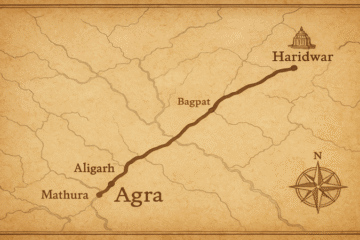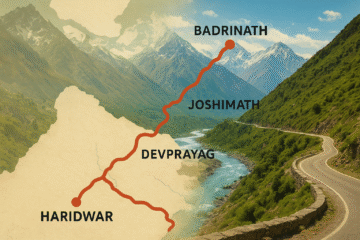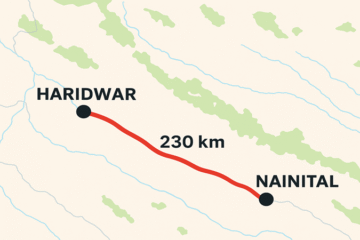
Table of Contents
Embarking on a journey from the bustling city of Pune to the serene, majestic abode of Lord Shiva in Kedarnath is an experience that blends spiritual fervor with an adventurous road trip. The Pune to Kedarnath distance by car is significant, spanning over 1,600 to 1,900 kilometers depending on the exact route taken, and requires meticulous planning. This extensive guide will provide you with all the essential information to navigate this epic pilgrimage by road, covering distance, routes, travel time, road conditions, best time to visit, and crucial travel tips.
Understanding the Pune to Kedarnath Distance by Car
The approximate Pune to Kedarnath distance by car ranges from 1,700 km to 1,960 km. This substantial distance translates to a driving time of roughly 30 to 35 hours, excluding breaks and overnight halts. It’s imperative to understand that this journey cannot be completed in a single stretch. It requires at least 2-3 days of driving, with multiple overnight stops, to ensure safety and comfort.
The Journey: Routes and Itinerary
While there isn’t one single “best” route, the most common and recommended path for a road trip from Pune to Kedarnath involves heading north through various states before reaching Uttarakhand.
Typical Route (Pune – Delhi – Haridwar/Rishikesh – Rudraprayag – Sonprayag – Gaurikund):
-
Pune to Delhi: This is the longest stretch of your journey, covering approximately 1,400 km. You’ll primarily be on well-maintained national highways like NH48. This leg itself will take around 20-24 hours of driving.
-
Overnight Stop Option: Jaipur, Udaipur, or a city closer to Delhi like Mathura/Agra are excellent choices for your first overnight halt. This breaks the journey into manageable segments.
-
-
Delhi to Haridwar/Rishikesh: From Delhi, you’ll head towards Uttarakhand, approximately 200-250 km, which takes around 4-6 hours. These cities serve as popular gateways to the Char Dham Yatra.
-
Overnight Stop Option: Haridwar or Rishikesh are ideal for an overnight stay. You can experience the Ganga Aarti in Haridwar or explore the spiritual vibes of Rishikesh.
-
-
Haridwar/Rishikesh to Rudraprayag/Guptkashi: The journey into the Garhwal Himalayas begins here. This segment covers around 160-200 km and involves winding mountain roads, taking approximately 6-8 hours. You’ll pass through scenic spots like Devprayag (confluence of Alaknanda and Bhagirathi rivers) and Srinagar (Uttarakhand).
-
Overnight Stop Option: Rudraprayag or Guptkashi are crucial halts before the final ascent to Kedarnath. Guptkashi is often preferred as it’s closer to Sonprayag and offers better accommodation options.
-
-
Rudraprayag/Guptkashi to Sonprayag: This is the final motorable stretch, typically 30-45 km from Guptkashi, taking about 1-2 hours. Vehicles are generally not allowed beyond Sonprayag.
-
Sonprayag to Gaurikund: From Sonprayag, you’ll need to take a local shared jeep or walk to Gaurikund, which is about 5 km away. This is the starting point for the Kedarnath trek.
-
Gaurikund to Kedarnath Temple: The ultimate leg of the pilgrimage is a challenging 16-18 km trek from Gaurikund to Kedarnath Temple. This trek can take anywhere from 6-10 hours depending on your fitness level. Alternatives include ponies, palanquins (doli), or helicopter services from Guptkashi/Phata/Sersi.
Estimated Itinerary (3-4 Days Driving):
-
Day 1: Pune to Jaipur/Delhi NCR (approx. 900-1200 km, 16-20 hours driving)
-
Start early from Pune. Drive through Maharashtra, Gujarat (if taking NH48), Rajasthan, and into Delhi NCR or nearby. Aim for an early evening arrival at your chosen overnight stop.
-
-
Day 2: Delhi NCR to Guptkashi (approx. 450-500 km, 10-12 hours driving)
-
Depart early from Delhi. Drive towards Haridwar/Rishikesh, then continue into the hills towards Rudraprayag and finally Guptkashi. The mountain roads require careful driving and can be slow.
-
-
Day 3: Guptkashi to Kedarnath (Trek/Helicopter)
-
Early morning, travel to Sonprayag and then Gaurikund. Begin your trek to Kedarnath. Spend the night in Kedarnath (prior booking of accommodation is highly recommended due to limited options).
-
-
Day 4: Kedarnath to Guptkashi/Rudraprayag and onward journey
-
After morning darshan and potentially Abhishek Puja, trek back to Gaurikund and travel to Sonprayag. From there, drive back to Guptkashi or Rudraprayag for another overnight stay before starting your return journey.
-
Note: This is a generalized itinerary. Your actual travel time will vary based on driving speed, stops, traffic, and road conditions. Always factor in buffer time.
Road Conditions and Challenges
The Pune to Kedarnath distance by car encompasses a wide range of road conditions:
-
Expressways and National Highways (Pune to Delhi): This part of the journey is generally smooth, with multi-lane highways. Expect tolls at various points.
-
Plains to Hills Transition (Delhi to Haridwar/Rishikesh): The roads are still good, but traffic can be heavy, especially around cities.
-
Hilly Terrain (Haridwar/Rishikesh to Gaurikund): This is the most challenging section.
-
Winding Roads: Expect numerous hairpin bends and steep ascents/descents.
-
Narrow Stretches: Some parts of the road can be quite narrow, especially in the interior areas.
-
Landslide Prone Areas: During monsoon (July to September), landslides are common, leading to road closures and delays. It’s advisable to avoid travel during peak monsoon.
-
Traffic Congestion: During peak pilgrimage season, the roads leading to Gaurikund can experience significant traffic.
-
Road Construction: The Char Dham Pariyojana aims to widen and improve roads, but ongoing construction can also cause diversions and delays.
-
Driving Hours Restrictions: In hilly regions, driving is often restricted between 7 PM and 5 AM due to safety concerns.
-
Vehicle Suitability: A sturdy car with good ground clearance is recommended for the mountainous terrain. Ensure your vehicle is well-serviced, especially the brakes and tires.
Best Time to Visit Kedarnath by Car
The best time to undertake the Pune to Kedarnath distance by car is during the opening months of the Char Dham Yatra.
-
Summer (April to June): This is the most popular time. The weather is relatively pleasant (10-15°C), and the roads are generally clear. However, expect large crowds and higher prices for accommodation and services. The temple usually opens around late April or early May (Akshaya Tritiya).
-
Post-Monsoon (September to October): This period also offers good weather with clearer skies after the monsoon rains. The lush greenery is vibrant, and the crowds are generally thinner than in summer. However, be mindful of any lingering effects of the monsoon on road conditions in early September. The temple closes around late October or early November (Kartika Purnima).
Avoid:
-
Monsoon (July to August): Heavily prone to landslides, flash floods, and incessant rain, making road travel extremely risky and unpredictable.
-
Winter (November to March): The temple remains closed due to heavy snowfall, and roads are blocked.
Essential Travel Tips for Your Road Trip
-
Vehicle Preparation:
-
Get your car thoroughly serviced, checking brakes, tires, engine oil, coolant, and lights.
-
Carry a spare tire, a jack, and basic tools.
-
Keep sufficient fuel, especially in the hills where petrol pumps are scarce.
-
Carry jumper cables, a tow rope, and a first-aid kit for your car.
-
-
Personal Preparation:
-
Physical Fitness: The trek to Kedarnath is demanding. Ensure you are physically fit. Consult a doctor, especially if you have any pre-existing health conditions.
-
Altitude Sickness: Kedarnath is at a high altitude (3,583 meters). Acclimatize gradually. Stay hydrated, avoid alcohol, and carry medication for altitude sickness if prone to it.
-
Packing: Pack layers of warm clothing, waterproof jackets, sturdy trekking shoes, a rain cover, a power bank, a good quality torch, and essential medicines.
-
Documents: Carry your driving license, vehicle registration papers, insurance, PUC certificate, Aadhar card, and a Yatra permit (if required, check latest regulations).
-
Cash: ATMs are limited in remote areas; carry sufficient cash.
-
-
Accommodation:
-
Book your stays in advance, especially during peak season. Haridwar, Rishikesh, Rudraprayag, and Guptkashi offer various accommodation options from budget to luxury.
-
Accommodation in Kedarnath near the temple is basic, primarily guesthouses run by the temple committee. Book well in advance.
-
-
Food and Water:
-
Carry snacks, dry fruits, and energy bars, especially for the trek.
-
Stay hydrated by drinking plenty of water. Avoid overeating heavy meals, especially at high altitudes.
-
Dhabas and restaurants are available along the route, offering local cuisine.
-
-
Driving Habits:
-
Drive cautiously, especially on winding mountain roads. Avoid speeding.
-
Honk at blind turns.
-
Avoid driving at night in the hills.
-
Take frequent breaks to avoid fatigue.
-
Monitor weather forecasts diligently, particularly if traveling near the monsoon season.
-
-
Connectivity:
-
Mobile network coverage can be erratic in some remote areas. Download offline maps.
-
BSNL and Jio generally have better connectivity in the hills.
-
-
Registration for Char Dham Yatra:
-
Mandatory registration is required for the Char Dham Yatra. Ensure you complete this process online or at designated counters before commencing your journey. This often includes a biometric registration.
-
Cost Considerations
The cost of your Pune to Kedarnath distance by car trip will vary significantly based on your vehicle, fuel prices, accommodation choices, food preferences, and personal expenses.
-
Fuel: Given the substantial distance, fuel will be a major expense.
-
Tolls: Expect numerous toll plazas along the national highways.
-
Accommodation: Budget-friendly hotels, mid-range guesthouses, or luxury resorts will dictate this cost.
-
Food: Local dhabas are economical, while restaurants in popular tourist hubs will be pricier.
-
Car Maintenance/Repairs: Factor in a contingency for unforeseen repairs.
-
Trek/Helicopter/Pony Charges: If opting for these, they will add to the cost. Helicopter services are significantly more expensive but save time and effort.
-
Miscellaneous: Personal shopping, entry fees (if any), etc.
A rough estimate for a comfortable road trip could range from INR 25,000 to INR 50,000 or more per person, depending on the number of travelers and their preferences. Cab services from Pune to Kedarnath typically start from INR 25,000 for a one-way trip, excluding accommodation and other expenses.
Conclusion
The journey from Pune to Kedarnath by car is an unforgettable experience, offering stunning landscapes, spiritual solace, and a test of endurance. While the Pune to Kedarnath distance by car is considerable and the terrain challenging, careful planning, adherence to safety guidelines, and a flexible mindset will ensure a smooth and rewarding pilgrimage. Prepare well, drive safely, and immerse yourself in the divine aura of the Himalayas as you make your way to the sacred shrine of Kedarnath.
Frequently Asked Questions (FAQs)
1. What is the total Pune to Kedarnath distance by car?
Ans. The approximate Pune to Kedarnath distance by car is between 1,700 km to 1,960 km, depending on the specific route you choose.
2. How many days does it take to complete the Pune to Kedarnath road trip by car?
Ans. It typically takes at least 2-3 days of driving to reach Sonprayag (the last motorable point) from Pune, excluding the trek to Kedarnath. Including the trek and a night at Kedarnath, the entire journey often spans 5-7 days for a round trip.
3. What is the best time to undertake the Pune to Kedarnath car journey?
Ans. The ideal time is during the opening months of the Char Dham Yatra, specifically from late April to June, and then again from September to October. Avoid the monsoon season (July-August) due to high risks of landslides.
4. Are the roads from Pune to Kedarnath suitable for all types of cars?
Ans. While the initial stretch from Pune to Delhi is on excellent highways, the mountainous roads in Uttarakhand (from Haridwar/Rishikesh onwards) can be challenging. A car with good ground clearance and in excellent mechanical condition is highly recommended. Small sedans might struggle on some rough patches.
5. Is it mandatory to register for the Kedarnath Yatra?
Ans. Yes, biometric registration is mandatory for the Char Dham Yatra, including Kedarnath. You must complete this online or at designated registration counters before starting your journey.
6. Where can I find accommodation during the Pune to Kedarnath road trip?
Ans. You’ll find ample accommodation options in major cities along the way like Jaipur, Delhi, Haridwar, Rishikesh, Rudraprayag, and Guptkashi. Accommodation near Kedarnath temple (at Gaurikund and Kedarnath) is basic and should be booked well in advance.
7. What are the options to reach Kedarnath Temple from Sonprayag/Gaurikund?
Ans. From Sonprayag, you take a local shared jeep to Gaurikund (5 km). From Gaurikund, you can trek the 16-18 km to Kedarnath, or opt for ponies, palanquins (doli), or helicopter services (available from Guptkashi/Phata/Sersi).
8. What are some key safety tips for driving in the Himalayas?
Ans. Drive cautiously, especially on winding roads. Avoid driving at night, honk at blind turns, and take frequent breaks. Always be aware of weather changes and potential landslides, especially during the shoulder seasons. Carry essential car repair tools and a first-aid kit.
9. What should I pack for the Kedarnath trek?
Ans. Pack layered warm clothing, waterproof jackets, sturdy trekking shoes, a rain cover, a power bank, a good quality torch, and essential personal medicines. Given the high altitude, be prepared for cold weather even in summer.
10. Are there any restrictions on driving hours in the hilly regions?
Ans. Yes, in many parts of the Uttarakhand hills, driving is restricted between 7 PM and 5 AM due to safety concerns related to winding roads, limited visibility, and potential for landslides. Plan your daily driving segments accordingly.


